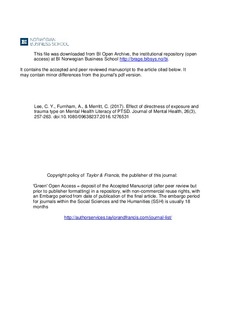Effect of directness of exposure and trauma type on Mental Health Literacy of PTSD
Journal article, Peer reviewed
Accepted version
Permanent lenke
http://hdl.handle.net/11250/2465826Utgivelsesdato
2017Metadata
Vis full innførselSamlinger
- Publikasjoner fra CRIStin - BI [1015]
- Scientific articles [2181]
Sammendrag
Background: Research has demonstrated that Post-Traumatic Stress Disorder (PTSD) is one of the most widely recognized mental disorders (Furnham & Lousley, 2012), but recognition is affected by trauma type (Merritt et al., 2014). Aims: The current study investigated the effect of direct versus indirect exposure to traumatic event and trauma types on Mental Health Literacy (MHL) of PTSD. Methods: 233 participants were asked to identify the mental health problem after presentation of an unlabeled vignette describing a character experiencing PTSD symptoms. The six vignettes described the same symptoms but differed in directness (direct/indirect exposure) and trauma type (rape, military combat or man-made disaster). It was hypothesized that [1] recognition rate would be higher in direct than indirect conditions, and [2] higher in military combat, followed by man-made disaster, and lowest in rape condition. Results: Overall, correct recognition of PTSD was 42.5%. Recognition in direct exposure vignettes was significantly higher than indirect, supporting the first hypothesis. The second hypothesis was only partly supported. While PTSD recognition in rape vignettes was significantly lower than the other two scenarios, no difference was found between combat and man-made disaster trauma types. Conclusions: Our findings implied under-recognition of PTSD, with lack of awareness of different causes of PTSD and of PTSD from indirect trauma exposure. The latter finding is important in the light of DSM-V revisions to diagnostic criteria for PTSD.
